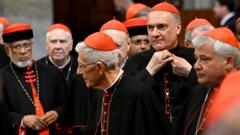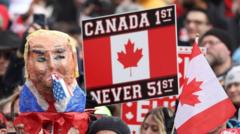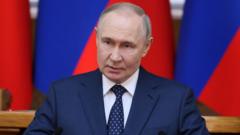As Canada heads to the polls today, citizens find themselves at a crossroads that could reshape the nation’s leadership and economic future amid President Trump’s volatile trade policies. The election pits two principal candidates against each other—Liberal Party leader Mark Carney, recently appointed prime minister, and Conservative leader Pierre Poilievre—with the race tightening significantly in recent weeks.
Canada's Election Day: A Pivotal Choice Amid Trump’s Trade Turmoil

Canada's Election Day: A Pivotal Choice Amid Trump’s Trade Turmoil
Canadians vote today, facing pressures from President Trump's tariffs and a shifting political landscape as two major parties vie for control.
Just three months ago, the Conservatives were projected to win by a wide margin. However, following Trump’s imposition of tariffs and the resignation of former Prime Minister Justin Trudeau in March, support surged for the Liberals. Carney, a former central banker, presents himself as a stabilizing figure capable of countering Trump’s economic threats. Poilievre, on the other hand, runs a campaign leaning into deregulation, evoking both admiration and concern among voters wary of his similarities to Trump.
Key issues at play include economic management under the looming threat of U.S. tariffs, inflation, and housing affordability—topics that have dominated discussions in the lead-up to the election. Both parties are under the scrutiny of voters who are increasingly concerned about Canada’s sovereignty and its ability to respond effectively to external pressures.
In today's election, voters will choose their local representatives across 343 parliamentary seats, which following the election, will determine who emerges as Canada’s next leader. With a closely contested race expected, results are anticipated by late evening, as ballots are counted manually—a hallmark of Canada’s electoral system.
Polls began to open throughout the nation earlier today, presenting a unique challenge with multiple time zones needing to coordinate a staggered closing approach. By 9:30 p.m. Eastern Time, most voting stations will have closed, though the final tally may take longer due to the manual counting process.
In this moment of uncertainty, Canada’s election resonates not only within its borders but also as the nation contends with external ideologies claiming ownership over Canadian goodwill and economic vitality. The outcome will dictate not merely the future of leadership, but also the direction of Canadian democracy in relation to U.S. influence.
Key issues at play include economic management under the looming threat of U.S. tariffs, inflation, and housing affordability—topics that have dominated discussions in the lead-up to the election. Both parties are under the scrutiny of voters who are increasingly concerned about Canada’s sovereignty and its ability to respond effectively to external pressures.
In today's election, voters will choose their local representatives across 343 parliamentary seats, which following the election, will determine who emerges as Canada’s next leader. With a closely contested race expected, results are anticipated by late evening, as ballots are counted manually—a hallmark of Canada’s electoral system.
Polls began to open throughout the nation earlier today, presenting a unique challenge with multiple time zones needing to coordinate a staggered closing approach. By 9:30 p.m. Eastern Time, most voting stations will have closed, though the final tally may take longer due to the manual counting process.
In this moment of uncertainty, Canada’s election resonates not only within its borders but also as the nation contends with external ideologies claiming ownership over Canadian goodwill and economic vitality. The outcome will dictate not merely the future of leadership, but also the direction of Canadian democracy in relation to U.S. influence.






















